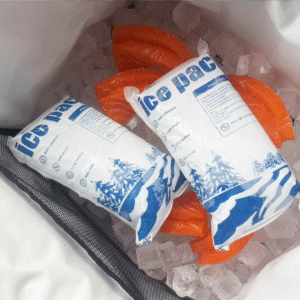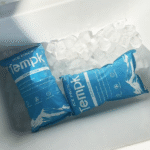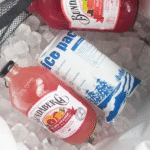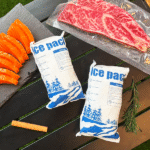Shipping perishable goods, especially in the cold chain logistics industry, requires careful consideration of the best cooling method. Dry ice and gel packs are the most commonly used materials, each having distinct advantages. في هذه المقالة, we will explore the differences between these two cooling agents, guide you on when to choose each, and discuss their benefits and limitations based on the 2025 cold chain shipping trends.

What Are Dry Ice and Gel Packs?
الجليد الجاف (CO₂ الصلبة):
Dry ice is frozen carbon dioxide that sublimates directly from a solid to a gas at -78.5°C (-109.3° f), making it perfect for extremely cold environments. على عكس الجليد التقليدي, dry ice does not leave any liquid residue, preventing potential water damage to sensitive products.
حزم هلام:
Gel packs are flexible containers filled with a non-toxic gel, which freezes and releases cold gradually over time. They work by absorbing heat from the surrounding environment, maintaining temperatures typically in the 2-8°C range, ideal for refrigerated goods.
When Should You Use Dry Ice for Shipping?
Dry ice is the go-to option when shipping products that need to remain at sub-zero temperatures, like pharmaceuticals, عينات بيولوجية, أو الأطعمة المجمدة. Its ability to sustain extremely cold temperatures for extended periods makes it ideal for long-distance shipments or shipments in hot climates.
Key Benefits of Dry Ice for Shipping:
-
Extreme Cold: Keeps items well below -78.5°C, essential for frozen foods and medical samples.
-
Long-Lasting: Sublimates slowly, offering prolonged cooling.
-
No Liquid Residue: Prevents potential product damage caused by melting.
Practical Example:
A pharmaceutical company shipping vaccines across the country may prefer dry ice to maintain the required ultra-low temperatures during the journey.
When Should You Choose Gel Packs for Shipping?
Gel packs work best for products that need to be kept cool, ولكن ليس مجمدة. They are ideal for temperature-sensitive goods like chocolates, مستحضرات التجميل, and certain medications. Gel packs offer a safer, non-toxic alternative to dry ice, and they don’t require specialized handling or packaging.
Key Benefits of Gel Packs for Shipping:
-
التعامل الآمن: No risk of burns or suffocation, unlike dry ice.
-
إعادة الاستخدام: Gel packs can be reused, making them a more cost-effective and environmentally friendly option for frequent shipments.
-
Customizable Cooling: Gel packs can be tailored to maintain specific temperature ranges, such as 2-8°C for pharmaceutical products.
جفاف الجليد مقابل حزم هلام: Pros and Cons Comparison
| ميزة | الجليد الجاف | حزم هلام |
|---|---|---|
| نطاق درجة الحرارة | -78.5درجة مئوية (-109.3° f) | 2-8درجة مئوية (32-46° f) |
| مدة التبريد | Long-lasting, can last for days | عادة 12-48 ساعات |
| التعامل مع السلامة | Requires caution (قضمة الصقيع, تراكم CO₂) | آمن, غير سامة |
| التغليف | Requires ventilated packaging | No special packaging needed |
| الاستخدام المثالي | الأطعمة المجمدة, الأدوية, عينات بيولوجية | Chocolates, مستحضرات التجميل, temperature-sensitive electronics |
How to Choose Between Dry Ice and Gel Packs?
The decision on which cooling agent to use depends on several factors, including the temperature requirements of the product, the shipping duration, and the handling risks.
-
متطلبات درجة الحرارة: If the product requires freezing, dry ice is the only option. For products that need to stay cool but not frozen, gel packs are the best choice.
-
مدة الشحن: Dry ice is better for longer shipments, while gel packs are ideal for shorter, less critical shipments.
-
التعامل مع السلامة: If your team isn’t equipped to handle hazardous materials like dry ice, gel packs are a safer alternative.
2025 اتجاهات السلسلة الباردة: Innovations and Sustainability
مع تطور صناعة السلسلة الباردة, sustainability and technology are becoming more integral. في 2025, eco-friendly alternatives to traditional cooling methods, such as biodegradable gel packs and low-GWP dry ice, are gaining popularity. العبوة الذكية, temperature tracking, and hybrid solutions combining dry ice and gel packs are also emerging as reliable methods to ensure the integrity of temperature-sensitive goods.
Key Trends for 2025:
-
Hybrid Solutions: Combining dry ice with gel packs to extend cooling duration.
-
العبوة الذكية: Embedding sensors for real-time temperature tracking.
-
الاستدامة: Increased demand for biodegradable and reusable cooling solutions.
التعليمات:
س 1: What is better for shipping temperature-sensitive products, dry ice or gel packs?
Dry ice is best for frozen items requiring ultra-low temperatures, while gel packs are ideal for products that need to remain cool but not frozen.
Q2: How long can gel packs maintain the required temperature?
Gel packs typically maintain temperatures for 12 ل 48 ساعات, depending on their size and cooling composition.
الخلاصة والتوصيات
Choosing between dry ice and gel packs for shipping depends on the nature of your product, the required temperature range, and your shipment’s duration. Dry ice is essential for ultra-cold goods, while gel packs are more cost-effective and safer for cool, non-frozen items. For many shipments, hybrid solutions combining both methods may offer the best results.
الخطوات التالية:
-
Evaluate Your Products: Identify whether they need to be frozen or just kept cool.
-
Use Hybrid Solutions: Consider combining gel packs with a small amount of dry ice for longer shipments.
-
Adopt Sustainable Practices: Explore eco-friendly gel packs or low-GWP dry ice to reduce environmental impact.
حول Tempk
Tempk is a leading provider of sustainable cold chain solutions, offering dry ice and gel packs for industries that demand reliable temperature control. Our innovative solutions ensure your goods arrive safely and in optimal condition. Reach out today for tailored advice on your cold chain shipping needs.























